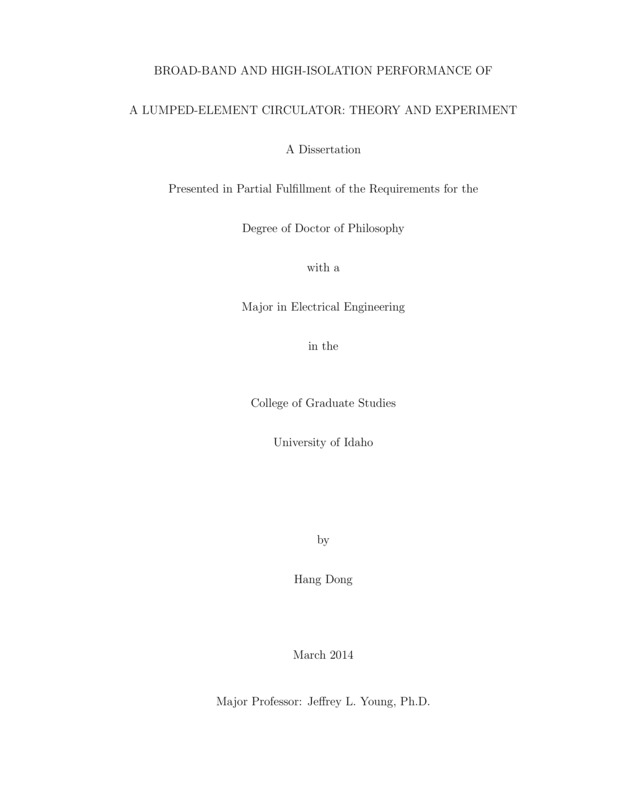Broad-band and High-Isolation Performance of a Lumped-Element Circulator: Theory and Experiment
Dong, Hang. (2014). Broad-band and High-Isolation Performance of a Lumped-Element Circulator: Theory and Experiment. Theses and Dissertations Collection, University of Idaho Library Digital Collections. https://www.lib.uidaho.edu/digital/etd/items/dong_idaho_0089e_10186.html
- Title:
- Broad-band and High-Isolation Performance of a Lumped-Element Circulator: Theory and Experiment
- Author:
- Dong, Hang
- Date:
- 2014
- Keywords:
- Bandwidth Demagnetization factor ferrite Isolation Lumped-element circulator
- Program:
- Electrical and Computer Engineering
- Subject Category:
- Electrical engineering
- Abstract:
-
Research on a wide-bandwidth, high-isolation, lumped-element, crossover ferrite circulator is presented. The presented research spans the entire range of activities including theory, simulation, fabrication, measurement and assessment of the device. The research is validated by experimental data that shows unprecedented bandwidths on the order of 130% and deep isolations on the order of 30 dB. To accomplish the stated research objectives, the research is subdivided into three key parts.
In the first part, a procedure based on an ideal analytical model of a lumped-element, crossover circulator for maximizing its operating bandwidth is presented. The procedure considers the circulator as a network and employs the circulation impedance---the load impedance associated with perfect circulation---as a metric to optimize the bandwidth. Using this optimization procedure, a maximum bandwidth of 194\% is obtained for an ideal circulator operating above ferromagnetic resonance (FMR). When the same procedure is applied using a simulation model for the 225-400 MHz frequency range, we achieve 125\% bandwidth. This result is verified by the measurement of a fabricated device, which reveals a bandwidth of 129%.
The second part presents a novel, spiral trace topology for a lumped-element, ferrite circulator. By employing this new topology, along with various optimization methods, a circulator with high isolation and wide bandwidth is achieved for UHF applications. Based on simulation data, an isolation of 30 dB or more is possible over the 250--350 MHz frequency range. When the new trace topology is applied to a fabricated device, we obtain a UHF circulator with isolation response exceeding 30 dB, but over a shifted and wider frequency range of 260 to 390 MHz.
In the third part, a numerical method used for calculating the demagnetization factor of a non-ellipsoid ferrite body is presented. The method divides the ferrite body into small elements and considers each of them as a small, uniformly saturated ferrite volume. Then from their vector potentials, the method calculates the demagnetizing field excited by every element and superimposes them to find the total demagnetization factor at a specified observation point. By utilizing this method, we found the demagnetization factors for several non-ellipsoid ferrite bodies, including an irregular shaped ferrite slab and a non-z-directed biased ferrite disk.
- Description:
- doctoral, Ph.D., Electrical and Computer Engineering -- University of Idaho - College of Graduate Studies, 2014
- Major Professor:
- Young, Jeffrey L
- Committee:
- Sullivan, Dennis; Atkinson, David; Edwards, Dean
- Defense Date:
- 2014
- Identifier:
- Dong_idaho_0089E_10186
- Type:
- Text
- Format Original:
- Format:
- application/pdf
- Rights:
- In Copyright - Educational Use Permitted. For more information, please contact University of Idaho Library Special Collections and Archives Department at libspec@uidaho.edu.
- Standardized Rights:
- http://rightsstatements.org/vocab/InC-EDU/1.0/

